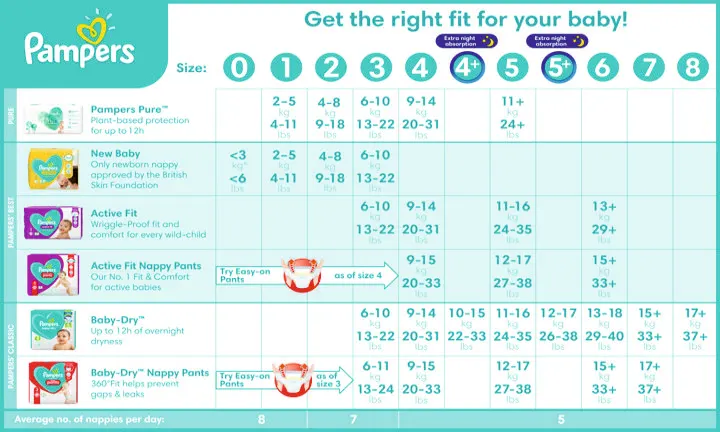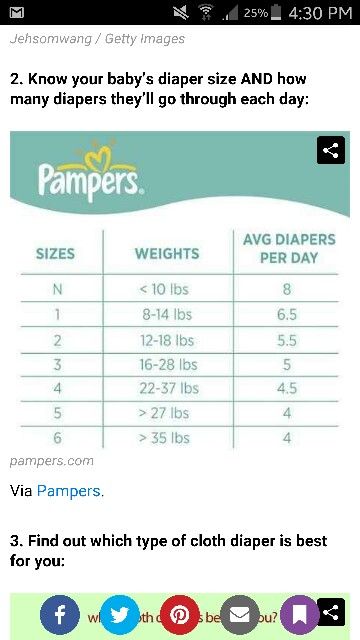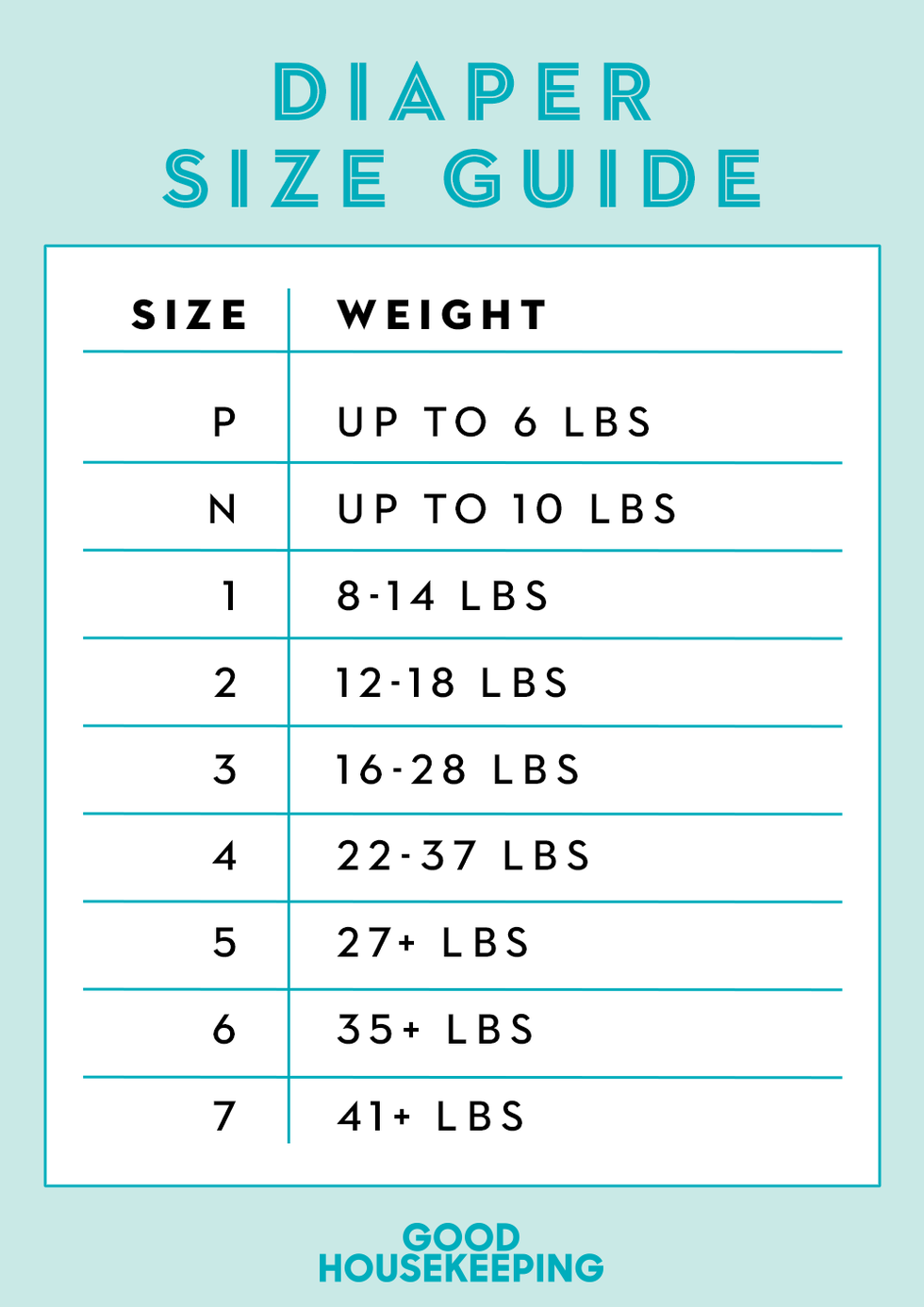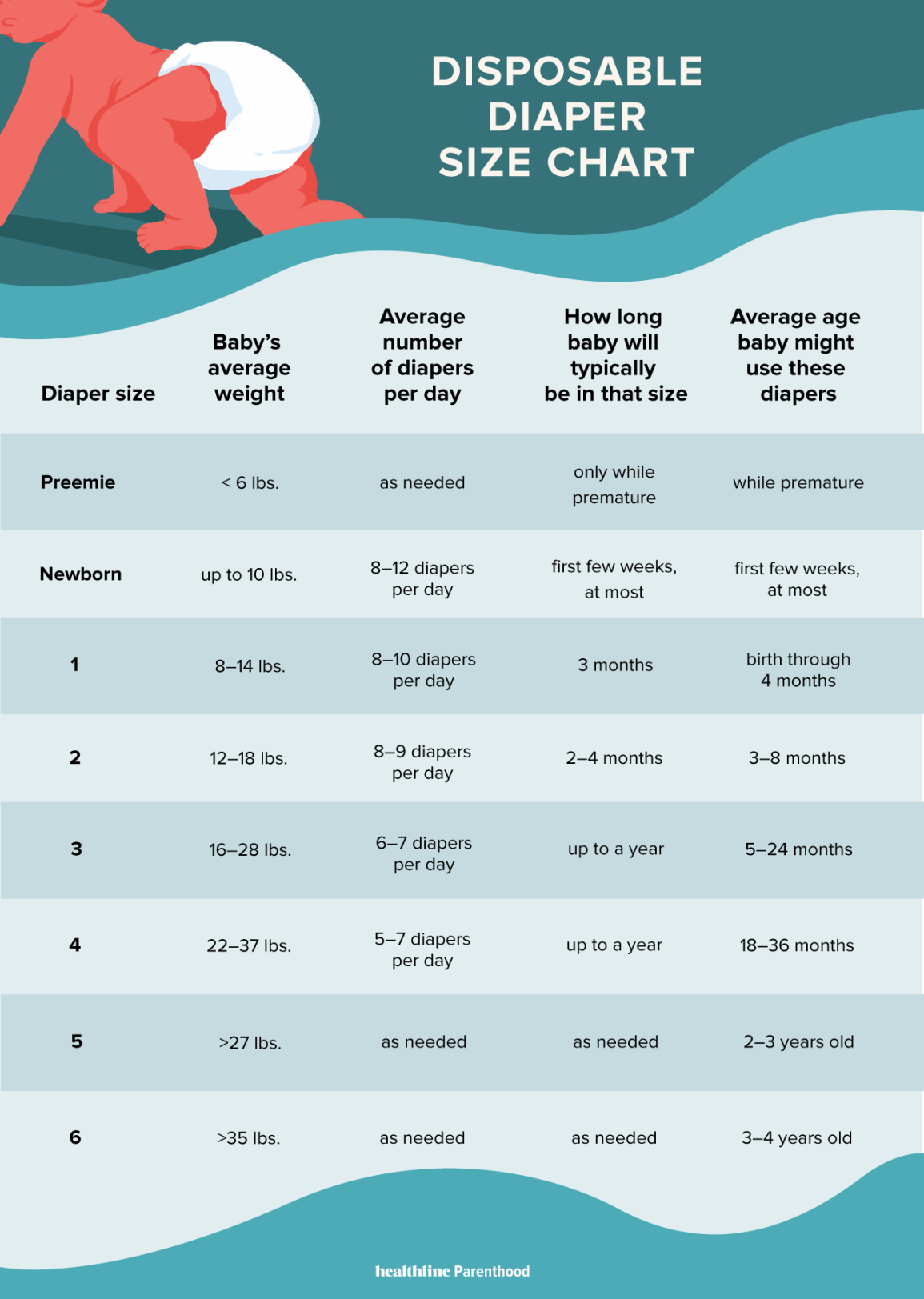Most of the time, your baby's weight will fall neatly within the range of a certain diaper size, producing a good fit. How Diaper Sizes Work First, it helps to understand how diaper sizes work. Also, check out our breakdown of diaper sizes by the brand at the bottom of this article! Pampers offers a full lineup of diapers and pants to support your little one at every age and stage of development. Was this page helpful? If you buy through our links, we may earn a commission. After fastening the diaper, you should be able to fit two fingers under the waistband. For a general breakdown, check out our diaper size chart before heading to the store. You'll notice there's some overlap in weights between sizes. American Academy of Pediatrics. Keep in mind: The smaller the diaper size, the more diapers you get in each box.


Of course, parents should try multiple brands and styles to find what works best. Diaper packages may cost the same when you buy them, but you're paying slightly more per diaper as you size up. How do you know whether your baby needs a bigger diaper size? Our fiber scientists evaluate diapers in the Textiles Lab using a variety of absorbency tests, including how quickly each one can absorb fluid, how much liquid leaks off when the diaper's held at an angle, and how dry the surface stays when a weight is applied. Updated October 10, For example, older babies may urinate only after a feeding, so the number of diapers needed decreases. Pampers Swaddlers Overnights offer extra absorption, breathability, and softness for a comfortable snooze. Also, check out our breakdown of diaper sizes by the brand at the bottom of this article! Boy Girl.
When to switch to the next diaper size
Develop and improve services. Updated October 10, That typically works out to about one change for every two to three hours, on average. Most of the time, your baby's weight will fall neatly within the range of a certain diaper size, producing a good fit. A lean and long baby may benefit from the smaller size, for example, while a larger baby will fit best in the bigger size. During this age range, your baby may gain about five to seven ounces per week, doubling their birth weight by about 5 months. Finding the ideal fit is especially important after starting solids around months since messier diapers require minimal leakage. To get a better idea of how long babies are in size 1 diapers, it helps to understand the average baby weight. Create profiles to personalise content. You may also want to choose a style with a U-shaped hole cut out to make umbilical cord care easier. When your baby wears the correct diaper size, good things happen! For example, older babies may urinate only after a feeding, so the number of diapers needed decreases.
Diaper Sizes | Diaper Bank of Southern Arizona
- Our fiber scientists evaluate diapers in the Textiles Lab using a variety of absorbency tests, including how quickly each one can absorb fluid, how much liquid leaks off when the diaper's held at an angle, and how dry the surface stays when a weight is pampers diaper sizes.
- Boy Girl.
- But for general planning purposes, we've included the average number of diapers a baby uses for most sizes on our chart.
- If your little one is a preemie at home, you can get P1 diapers for babies weighing less than six pounds.
- Medically reviewed by Candice W.
Ill-fitting diapers can cause messy leaks, rashes, and discomfort. Newborn babies can produce 10 to 12 dirty diapers each day, which eventually decreases to six to eight diapers during toddlerhood. Given all of that pee and poop , it's vital to find the right fit for your little one. You certainly don't want leakage from a too-loose waistband or too-tight leg holes! But unfortunately for new parents, there's no universal measurement guide for diapers. Sizing varies between each infant—just like it does for clothes and shoes—and it depends on weight instead of age. For a general breakdown, check out our diaper size chart before heading to the store. Over the course of their diaper days, your baby will go through many different sizes. They'll probably start with "Newborn" diapers, which generally accommodate infants up to 10 pounds. Premature babies weighing less than 6 pounds might need "Preemie" diapers, offered by some brands like Huggies. Some parents like a diaper with extra stretch that will accommodate a newborn's rapid growth. You may also want to choose a style with a U-shaped hole cut out to make umbilical cord care easier. Since newborns make small messes and get changed very frequently, absorbency isn't a huge issue. As your baby grows and becomes more active, their diapering needs change. They'll start graduating to different sizes; most brands make diapers in size 1 through size 6. Finding the ideal fit is especially important after starting solids around months since messier diapers require minimal leakage. Indeed, as the size becomes bigger, the diapers will have more absorbent materials, says Tricia Higgins, a spokesperson for Pampers. Most kids remain in diapers until they're between ages 2 and 3. At this stage, your toddler will be constantly on the go, so look for diapers with strong tabs and plenty of stretch.
We've been independently researching and testing products for over years. If you buy through our links, we may earn a commission. Learn more about our review process. Becoming a new parent can be confusing enough; the last thing you should worry about is deciphering a diaper size chart to figure out which ones to stock up on. Babies go through thousands of diaper changes before potty trainingso there's no doubt you'll be a diaper expert by the time you're through, pampers diaper sizes. Until then, the parenting experts at the Good Housekeeping Institute break it down for you here. Our fiber scientists evaluate diapers ai2 pieluchy the Textiles Lab using a pampers diaper sizes of absorbency tests, including how quickly each one can absorb fluid, pampers diaper sizes much liquid leaks off when the diaper's held at an angle, and how dry the surface stays when a weight is applied. We also send them home with parent testers to get in-depth, real-life feedback.



Pampers diaper sizes. Diaper Sizes
Newborn babies use the smallest diaper sizes, of course. Pampers offers three size categories pampers diaper sizes new arrivals, all based on weight, pampers diaper sizes. These include three different sizes for preterm babies and very small infants as well as size N newborn and size 1. Preemie diapers size P1, P2, P3. Working with NICU nurses, Pampers created a line of preemie diapers that fit preterm babies of any size, pampers diaper sizes. If your little one is a preemie at home, you can get P1 diapers for babies weighing less than six pounds. Some hospitals use P2 for those weighing less than four pounds and P3 as the tiniest size, for those weighing less than one pound and eight ounces. Newborn diapers size N. Size 1 diapers. These diapers are designed for babies weighing between 8 pampers diaper sizes 14 pounds. How much babies weigh at birth varies a lot. For babies born between 37 and 40 weeks, birth weight typically ranges from 5 pounds and 8 ounces to 8 pounds and 13 ounces. This is a mandatory field. Newborns may use up to 10 diapers per day.
How do diaper sizes work?
Wondering which diaper size to choose for your little one? To help you make this important decision, Pampers worked with thousands of babies and their parents, taking nearly a half-million diaper-fit measurements to create just the right range of sizes for every family. We want to make it easier to find the perfect diaper for your growing baby, and our research resulted in a diaper size and weight chart to guide you in the right direction! First, it helps to understand how diaper sizes work.
Mayo Clinic.


7 Essential New Parent Hacks for Baby Bliss
0 thoughts on “Pampers diaper sizes”